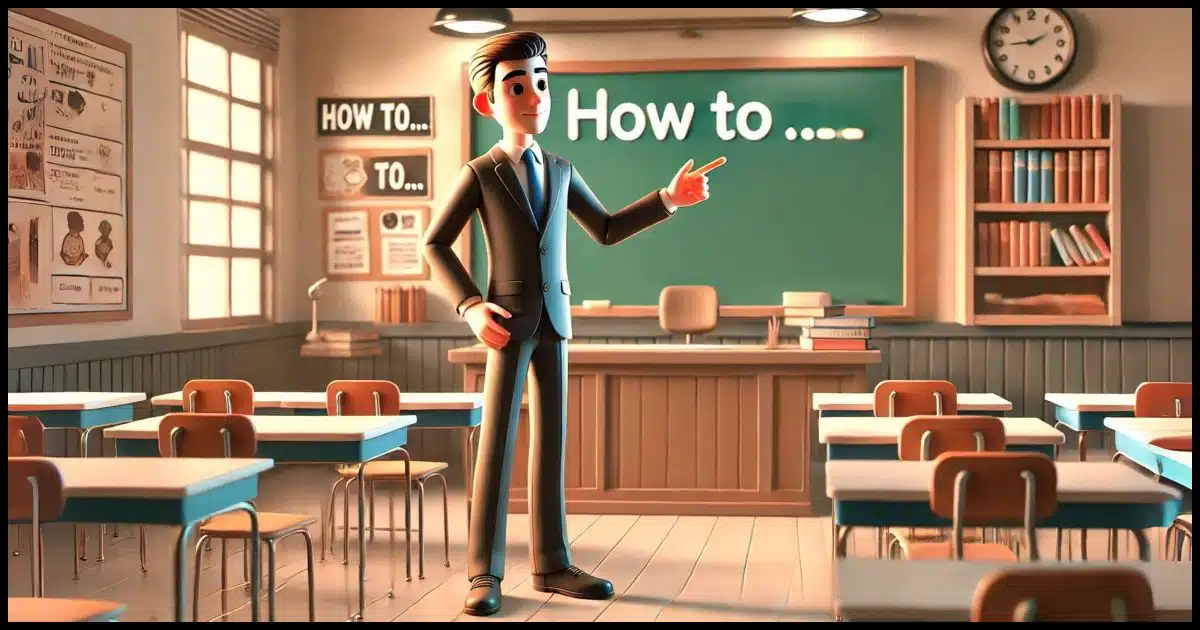Whether you know it or not.

Some time ago, in an article called The Deep, Dark Secret Behind Ask Leo!, I shared a secret that isn’t that deep or that dark.
I answer people’s tech questions and sneak in some education when they’re not looking.
In that statement, there’s an opportunity for you.

The path to greater confidence with tech
You have problems; I have answers — and a little education on the side. You want solutions, but what you need is understanding. A little learning today means fewer problems tomorrow. No lectures; just helpful advice to make tech less frustrating and more empowering. The more you know, the easier it gets.
Problems, solutions, and education
In my experience, there’s a fundamental conflict when anyone tries to help you with technology: what you want and what you need may be two different things.
- What you have is a problem.
- What you want is a solution.
- What you need is some education.
Often just a little bit of education will not only get you a solution to your problem, but you’ll be less likely to need help with similar issues in the future.
Ultimately, you’ll be more self-reliant.
You’ll need me, or people like me, a little less. And for the record, I’m okay with that.
Help keep it going by becoming a Patron.
Education need not be scary
The education I’m talking about doesn’t have to be overwhelming. It could be as simple as learning a term or understanding the difference between confusingly similar things. It could be learning how to clear a browser cache when you experience a certain type of problem.
There are plenty of opportunities.
And therein lies my challenge.
You want answers, not lectures
People resist education, often strongly. “I just want it to work” often comes with the implication that “I shouldn’t have to think about it to make it work.”
Sadly, that’s not the world we’re in. And while it’s easy to point at computers as the culprit, it really never has been the world we live in. Beginning with the wheel, every new technology has required some amount of education to get it to do what we want it to do. In that sense, computers and modern technology are no different.
We can try to reduce the amount of education needed, but it’ll never be zero.
Not lectures, but advice
Of course, no one wants to be lectured at. That’s my challenge (and the challenge of anyone trying to teach anything anywhere).
While “sneaking in” some education while you’re doing something else is nice, it’s not enough. Sometimes education needs to be explicit. The challenge for me and people like me is to make it understandable and palatable.
The challenge for you is to be open to it.
Do this
Look for opportunities to learn a little every day.1
It’s why I’m in this industry. Not a day goes by where I don’t learn something, and that — to me — is wonderful.
The more you know, the better your technology works for you, and the more confidence you’ll have. And the better this stuff works, the more exciting, empowering, and fun it can be.
One way to do it is to subscribe to Confident Computing! Get less frustration and more confidence, solutions, answers, and tips in your inbox every week.
Podcast audio
Footnotes & References
1: Heck, learn enough to put people like me out of a job. I challenge you!



Hi Leo, I know where you are coming from. I started work as a trainee telecom technician when I was 15. I left school at grade 10 after getting very good grades in maths and science subjects. When I was finishing my traineeship I went back to college at night and did a certificate in Radio and TV Servicing which I passed. I then went back to school at night and did years 11 and 12 and passed all subjects. My employer then gave me time off to study for a diploma in electrical engineering and I passed that successfully. When computer controlled telephone exchanges I volunteered to get involved with the installation and commissioning of them. I underwent the required training and was promoted after several of experience to a level 2 support position. This spurred my further interest in computers and I went to University and successfully completed a Bachelor of Applied Science – Computing. I was a manger of a IT group supporting 6000 PC on a large corporate LAN. When they decided to centralise support to a city far from my family, I decided to move to a IT Network Architecture Design position and finished my working at that in 2002. Since then I spent 19 years as a volunteer teaching seniors how to use computers and other technology. The last few years due to health conditions catching up with me I have just been running a group to help seniors with IT/Technology problems and doing presentation on computers, mobile phones and other technology at a seniors computer club. I read all your emails and posts and forward on the ones I think my groups will understand. I find some seniors catch on real fast and others have problems. My oldest senior is 94 this year and she does understand.
For the past year or so and especially with recent changes made by Microsoft (OneDrive, Outlook for Desktop and Copilot, I have become more aggressive in using the local Group Policy Editor, Registry Editor and Powershell to undo changes or remove what Microsoft considers features. And, if something does go awry, I know that I can troubleshoot it with some idea of what I’m doing.
I haven’t decided whether Microsoft is dumbing down Windows or is pushing hard to get people to clutter up their machines with apps that really don’t add anything. Especially for people like myself that don’t use tablets or touchscreens.
Some of the changes seem designed to use consumers for guinea pigs to test new features. Most businesses where I can glimpse their computers certainly don’t appear to be using the bulk of what Microsoft is pushing to consumers.
Anyhow, it gives me something to do in my retirement.
I believe Hanlon’s Razor applies to Microsoft.
“Never attribute to malice that which is adequately explained by stupidity.”
Always remember, Microsoft is a profit-oriented corporation. Their only objective is to generate profit for their investors/stockholders, not for the user’s ease of use (unless, of course, it’s believed to increase profitability/increase the customer base).
Ernie
Leo,
I’ve learned a lot from you over the years, and I’ve learned a lot more by trying things, just to see what would happen. That’s how I learned the value of a good backup regiment early on :). That’s also why, at my mid-seventies, I consider myself to be a bit of a Windows/GNU Linux power user. I’m always experimenting, trying to make my computer do things I want it to do, but that it doesn’t do out-of-the-box.
I consider my computer(s) to be universes of possibilities unto themselves, just for me to explore. I’ve been exploring these ‘universes’ since the late 1990s, and I haven’t learnt everything yet, so as long as I live, I’ll keep exploring. I call each new thing I explore an adventure, because you can never know what you’ll find next. I’ve even had a few adventures lead to several new adventures along the way. It’s never-ending, and I’d have it no other way.
Thank you, Leo, for all you do here, and I hope you find a few fascinating adventures of your own along the way too,
Ernie